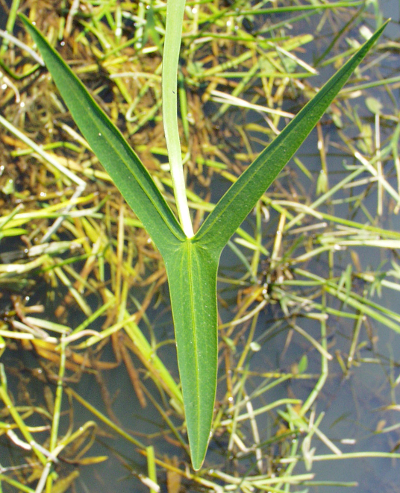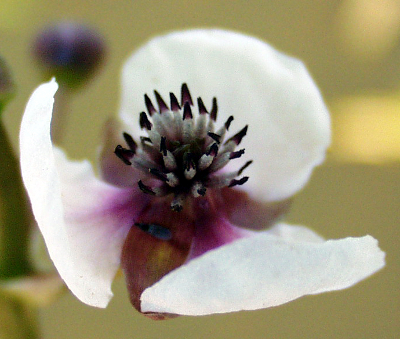Sagittaria |

Sagittaria species have arrow-shaped air leaves

Flower of the arrowhead (Sagittaria sagittifolia)
The approximately 25 species of the genus Sagittaria occur on every continent. The genus consists of mostly perennial, herbaceous, monoecious or dioecious aquatic plants. Frequently they have surface runners, that arise from the leaf axils, and chambered, sometimes bulbous rhizomes. The upright, often triangular stems bears tape- or spatula-shaped submersed leaves, floating leaves and air leaves. The air and floating leaves are simple and entire as well as stalked. The petioles are 3- to 4-edged. The leaf blade is linear, lance-shaped, hastate, ovoid or arrow-shaped.
The flowers, mostly standing above the water surface, have 3 white petals and 3 sepals which are arranged offset in relation to each other. They are usually arranged in threes in consecutive whorls, rarely in umbels. The inflorescence with the whorls may be branched further. The flower-stalks are each surrounded by a lance-shaped bract, which is shorter than the peduncle.
The monoecious plants develops unisexual male and female flowers in different parts of the plant. On the top of the inflorescence occur only male flowers on long and slender stalks. They possess 6, 7, 9, or up to 30 stamens. At the lower part are female or bisexual flowers on short and thick stalks or they are sessile. Up to 1500 spirally arranged, superior and free carpels are present.
After insect pollination often spherical heads (aggregated fruits) are formed from the female flowers. The single fruits are beaked nutlets (achenes), that are strongly flattened, usually winged, thin, and buoyant for several days.
| General floral formula: |
| * K3 C3 A6–∞ bzw. * K3 C3 G∞ superior |
Historical publications
Pliny (about 23–79 AD.) in his Natural History quoted Mago, a Punic author of 28 long-lost agricultural books. He wrote, that the Greeks would call a plant as Pistana, that will be counted among the water grasses. In Latin it would be named Sagitta. Peeled and dried in the sun it would serve as a weaving material.
Pietro Andrea Mattioli (1501–1577) distinguished between a small and a large Sagitta. The leaves would possess a peak on top and two at the bottom, the petioles were triangular and hollow. The stem would be erect, smooth and hollow as that of the rushes. On the branches were sitting white flowers with three petals. Between the stems would appear round, brown spheres, large as hazelnuts, inside with a thin seed. As therapeutic bath or beverage it would help against infertility in women.
Meaning of the species name
- sagittifolia: lat. sagittifolius = with sagittate leaves
Interessantes am Rande
Saggittaria subulata, the seaside arrowhead, is traded as low-maintenance aquarium plant.
Sagittaria sagittifolia, the arrowhead, is cultivated in China for its edible tubers.